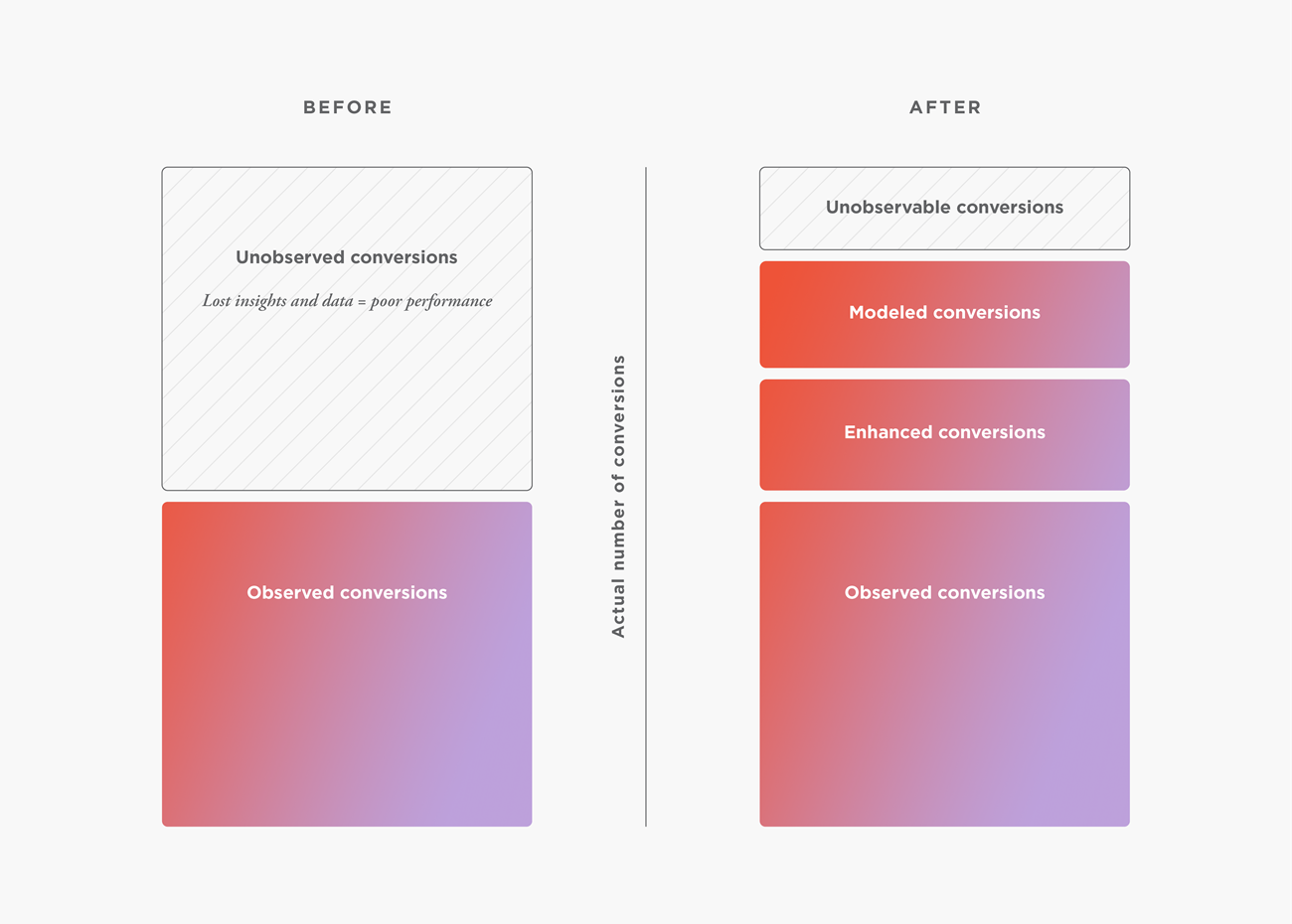How to Track Ad Effectiveness Without Third-Party Cookies
What's New Now
You may have heard that Google Chrome plans to phase out third-party cookies by early 2025 in response to increasing demand for user privacy. Third-party cookies track user behavior across websites and, without them, it’s going to be a whole lot harder for marketers to attribute specific conversions to specific ads. As you can imagine, Google has been working on alternative ways to measure ad conversions—both for online conversions (ex: submitting a lead form) and for offline conversions (ex: an in-store purchase).
Up to this point, all proposed solutions have been in beta testing and none have been formally rolled out as the final solution for advertisers. Google has finally shared its solutions to conversion tracking for Google ads and is instructing agencies like us and advertisers like you to set up “enhanced conversions”—see more on this below. Google is hopeful that its new suite of measurement solutions will make up for the significant data gaps that will be created by the deprecation (loss) of third-party cookies.
How Measurement is Changing
As the image below shows, before cookie deprecation, advertisers relied solely on "observed conversions" through Google tags to track the number of conversions their ads produced. After cookie deprecation, Google is officially adding two additional forms of attribution in an attempt to cut down on the number of “unobserved conversions.” Moving forward, Google ads will rely on the following suite of conversion measurement methods, designed to work in tandem to result in better overall conversion tracking:
- Observed conversions – Tracked through the legacy conversion tags that advertisers have used for attribution in Google Ads up to this point; however, instead of using third-party cookies, it will use first-party cookie-based measurement. (This will result in many fewer conversions being tracked by this method.)
- Modeled conversions – Google uses AI to predict attributed conversions in an effort to provide a more accurate view of performance when conversions cannot be observed due to protecting user privacy or technical limitations. The main goal is to provide advertisers with more data to optimize ad campaigns towards.
- Enhanced Conversions – Gain insights into cross-device and view-based performance that are measured by matching first-party data to complement first-party cookies.
 Google Ads Tracking Stack | Before & After Cookie Deprecation
Google Ads Tracking Stack | Before & After Cookie Deprecation
Better or Just Different?
These three solutions together, according to Google, are meant to help fill the attribution chasm that will be created in the post-third-party-cookie future. And with each form of measurement being considered supplemental to the other, Google also says this suite of measurement will bring to light even more of the unobserved conversions than its predecessor, third-party cookies.
Deeper Dive into Enhanced Conversions
Most advertisers already have the Google tag (gtag. js) implemented and will not need to take any additional action to implement observed or modeled conversions. A beta version of enhanced conversions was introduced for testing back in 2021, among other alternatives, as a means for using first-party data for conversion attribution. Many advertisers chose to wait to implement enhanced conversions until it was fully vetted to ensure this method would stick and make it past beta testing. Fast forward to today, not only has it made it past beta testing, but it also has iterated over the years to include new features. If you haven't set up enhanced conversions yet or learned about the new iterations, read on to learn more.
Enhanced Conversions for Web
Google describes website lead conversion tracking, technically called “enhanced conversions for web,” as a process that takes customer-provided, first-party data, hashes it, and sends it securely to Google Ads to be matched in aggregate for conversions to be reported in your Google Ads account. This measurement increases the observable first-party data your Google tag alone will not be able to track in some cases, counting conversions that would otherwise be lost due to browser restrictions. The main point of clarification here is that the enhanced conversions for web feature only works for conversions that include a user's email at a minimum and will not work for actions such as an intent click.
Enhanced Conversions for Leads
The “enhanced conversions for leads” feature enables you to measure sales and transactions that start as website leads and finish as conversions offline. Unlike the beta version released in 2022, the current iteration tracks offline conversions without the storage of a GCLID in your CRM. (GCLID stands for Google Click ID and is a parameter passed in the URL with ad clicks that identifies the campaign and other attributes of the click for ad tracking and campaign attribution.) Similar to enhanced conversions for web, enhanced conversions for leads supplements your existing conversion data by sending hashed first-party data to Google in a privacy-centric way.
A Use Case for Enhanced Conversions
Let's say a bank is trying to track a customer from ad click origination to product application and finally to application approval. Website product applications would likely be tracked via enhanced conversions for web but product approval is an action that would likely happen offline. Passing these approvals back to Google ads via enhanced conversions for leads would allow the advertiser to optimize their ad campaign not only to interested customers but to the most qualified (likely to be approved) customers as well.
If you haven't started thinking about what changes and updates you need to make to ensure continued Google advertising tracking and optimization in the post-third-party-cookie future, the time to start is now.
If your Google tags are already in place, they will continue to work. Just make sure your Gtag is set up properly. A good goal would be to implement and set up enhanced conversions before Q4. To implement enhanced conversions for web, refer to this article that outlines the steps for getting started and the choices you have to choose from for collecting data. To implement enhanced conversions for leads, refer to this article that walks you through setup and provides options for data importing. When in doubt or if you get stuck, we recommend speaking with a developer to ensure proper setup.
If you’d like to chat about this topic with one of our analysts or need help with implementation, reach out to your WR Account Executive or contact us today.



